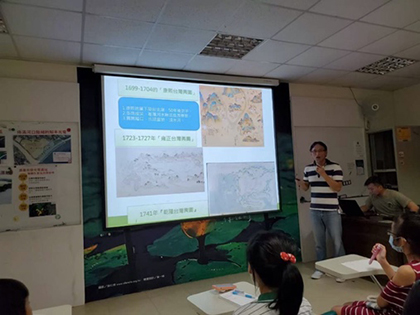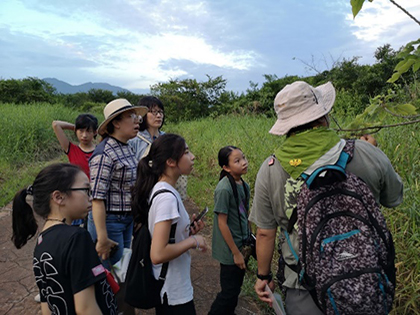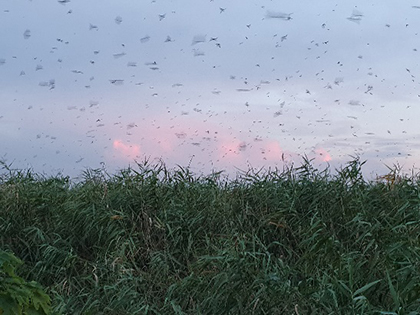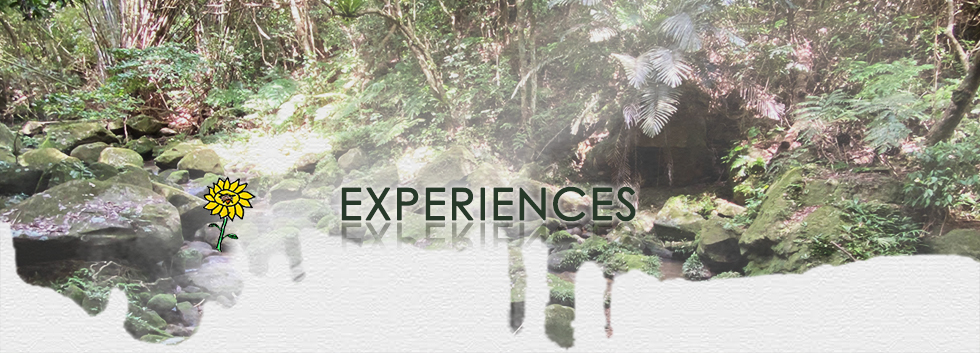Organized by Tzu-Chun
Wetland Ecosystem
(A) Wetland Info Session
Wetland has three key elements: water, soil, and hydrobios. The Ramsar Convention is a treaty adopted on February 2, 1971. It is the first global treaty on the conservation and sustainable use of natural resources of wetlands, setting the basic standard to protect valuable natural resources.
Wugu Wetland was previously known as “Zhouziwei.” The area was originally occupied by barns. Shizitou Aikou (Lion Head Pass) was blown up due to flood, but the surrounding area was plagued by seawater intrusion, turning fields into swamps! Wugu Wetland was created as a result of this beautiful mistake.

Source: Wilderness Crossing

Source: Wilderness Crossing
Commentator “Wild Deer” told us many advantages of wetlands, for example, wetland’s productivity is 2-3 times that of agricultural lands with the ability to purify water quality and detain floods. The intertidal zone can prevent coastal erosion and desalinate salt water to avoid salt erosion. The wetland ecosystem provides rich resources and habitat for migratory birds and other species. It also has educational and recreational functions.
Unfortunately, waste water and garbage were dumped to the wetland due to industrial development and selfishness of human beings, combined with invasion of alien species, excessive reclamation, and overfishing, Wugu Wetland had disappeared in 1996. In 2004, the Society of Wilderness and New Taipei City Government collaborated to adopt Wugu Wetland and planted the seeds of hope for restoration.

Source: Wilderness Crossing

Source: Wilderness Crossing
The Next commentator “Huatiao” explained the ecological diversity of Wugu Wetland. According to the Society of Wilderness habitat monitor log, there are 45 families and 160 species of birds, including 25 protected species such as Peregrine Falcon, Osprey, Chinese Egret, and Brown Shrike. For insects, there are 16 families and 57 species, including Mortonagrion hirosei, which can only be found in Wugu Wetland and surrounding area, and is an IUCN listed “endangered” species. In addition, there are 52 families and 154 species of plants. The wetland contains the largest reed swamp in northern Taiwan, providing valuable resources and habitat for a variety of species including Mortonagrion hirosei and swallows.

Source: Wilderness Crossing

Source: Wilderness Crossing
(B) Wetland Birdwatching
Wugu Wetland is located at the intersection of saltwater and freshwater and contains lots of ecological resources and species. Every year in the month of July and August, Wugu Wetland serves as a site for swallows before they depart on their southward migration. It is estimated 20-40,000 swallows may gather at the Wugu Wetland, including migratory birds and transit birds.
There are four common types of swallows: Barn Swallow, Pacific Swallow, Plain Martin, and Striated Swallow. According to the narrator, most Barn Swallows come from the Philippines, Laos, and Vietnam, travelling speeds can reach 40-70 km/h. In order to be able to fly long distances at such speed, Barn Swallows only weigh about 17-19 grams, which is lighter than a NT50 coin, no wonder we have an idiom “light as a swallow”.

Source: Wilderness Crossing

Source: Wilderness Crossing
We have discovered many insects and creatures within Wugu Wetland Ecological Park. One thing that caught our attention was seeing one hole after another on the roadside. These holes turned out to be the trace of crabs moving in-between tides.
We stationed on the bridge in front of reeds to wait for the swallows to appear. Started with just a few swallows circling around in the air, sometimes in v-shape and reverse-v formation. At 18:20, thousands of swallows appeared, ascending, diving, and gliding, showing us their superb flying skills over the reeds. People could not take their eyes off the dancing shadows in the air. Many swallows flew extremely low and passed over our heads several times, giving us goosebumps!

Source: Wilderness Crossing

Source: Wilderness Crossing
In this swallow observation, we were able to see swallows dancing in the air. In addition, through vivid guides and educations from Society of Wilderness volunteers, we learned to distinguish the characteristics of various swallows and gained knowledge about migration and behavior of swallows. Laws of nature are truly amazing. Now, any member of our team who looks up and sees swallows flying in groups, will know that they are simply returning to their nest, feeling much more relaxed and appreciative of having swallows around.

Source: Wilderness Crossing

Source: Wilderness Crossing

